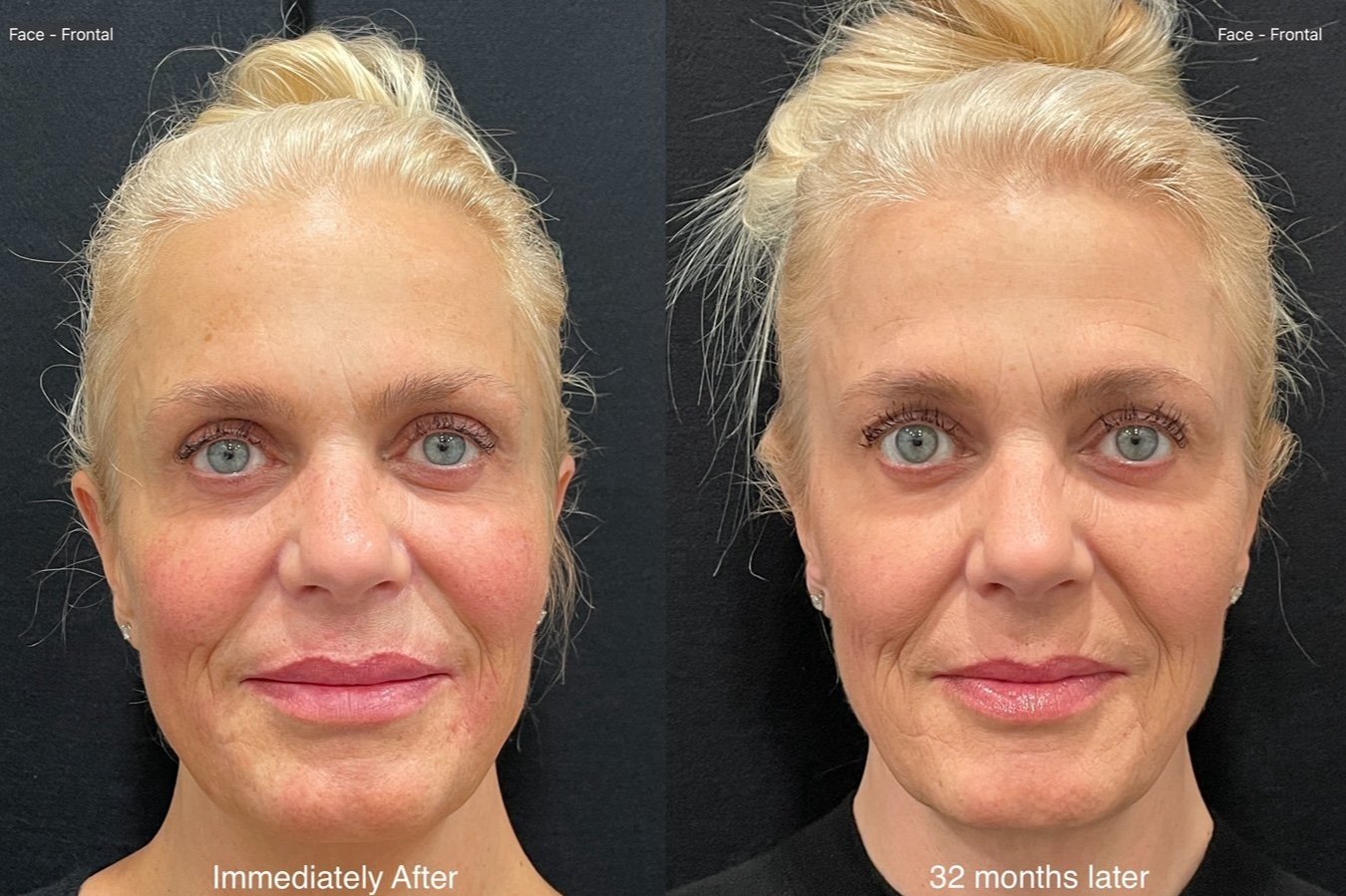How Long Does Filler Really Last? Breaking the Myth:
Hyaluronic Acid (HA) Filler is often described as “temporary.” Patients are told results should last for up to 1-2 years, maybe 6 months for lips. But is this really true?
I’ve had the privilege of working in the aesthetic industry since 2019 after retiring from a 20-year career in Emergency Medicine. Some of my patients have had filler injected over the course of 10-20 years (mostly at other places). Fortunately, at Rejuve Medspa, I use ultrasound to assess anatomy before injecting or dissolving any filler. I have noticed that people tend to believe that their old filler has mostly “worn off” when they get more filler. However, instead of filler completely degrading, I believe it often still exists and builds up over time.
A Case Study of Filler Injection:
This lovely client had Juvederm filler about 32 months prior to her follow up photos. She was kindly willing to share her experience. Assessment with ultrasound revealed that she still had filler to the areas which were previously injected. Her after photos look quite similar 32 months later. Keep in mind that immediately after filler injection, you can expect some swelling from the injection itself which typically reduces over the next couple of weeks.
Which Filler Lasts the longest?
In my experience with various fillers (Juvederm, Restylane, RHA), I’ve noticed that Juvederm is particularly long-lasting and very difficult to dissolve with Hyaluronidase.
Are some fillers permanent?
Some fillers such as Bellafil are considered permanent because it is made with non-resorbable polymethylmethacrylate (PMMA) microspheres. Whereas Hyaluronic Acid fillers can be dissolved with Hyaluronidase, Bellafil cannot be dissolved. Permanent fillers are much riskier to inject, especially if accidentally injected into an artery. Long term complications of permanent fillers can lead to granuloma formation, auto-immune response or infection. Increasing reported complications associated with permanent soft tissue fillers have led the national medical societies and governmental institutes in Europe to send out warnings regarding their use (see reference link: https://www.ncbi.nlm.nih.gov/pmc/articles/PMC2714892/). As a result, many countries in Europe have banned the use of permanent fillers such as Bellafil (formerly known as Artefill).
What Happens to Filler after a year or More?
Hyaluronic acid filler eventually becomes more stiff and may cause swelling due to the affinity of water. Filler's tendency to attract water may sometimes cause a puffy appearance, often delayed until several years later.
A volumetric MRI study of filler performed on a patient who reported having 12 syringes (12 mL) of filler over the course of 6 years revealed a total volume of 28 cubic cm - more than double the volume originally injected. Read a reference article: Newsweek article
Can Filler Migrate from where it was injected?
Muscle contractions, over-filling and gravity over time can cause filler to migrate from where it was originally injected. Filler migration may lead to distortion of facial features. Avoiding over-filling can minimize the risk of migration. Certain high risk areas such as the under eye (tear trough) areas should be avoided.
Benefits of Dermal Filler:
Dermal filler is an attractive option for those seeking a nonsurgical approach to improving facial volume. Results of dermal filler are immediate with little to no downtime. Judicious use of dermal filler can provide natural-appearing and long-lasting results.
What other types of treatments can replace facial volume besides Hyaluronic acid filler?
Sculptra is a biostimulator that stimulates your own body’s production of types I and III collagen. The volumizing effects of Sculptra happen slowly and increase over the course of several months. Results of Sculptra are FDA cleared for 25 months.
Renuva is an extra-cellular matrix that promotes your own body to grow fat. The life cycle of your own fat cells can be up to 10 years. Since the primary reason for loss of facial volume is due to loss of fat, replacing lost fat with your own fat can produce the most natural-appearing and most natural-feeling outcome.




